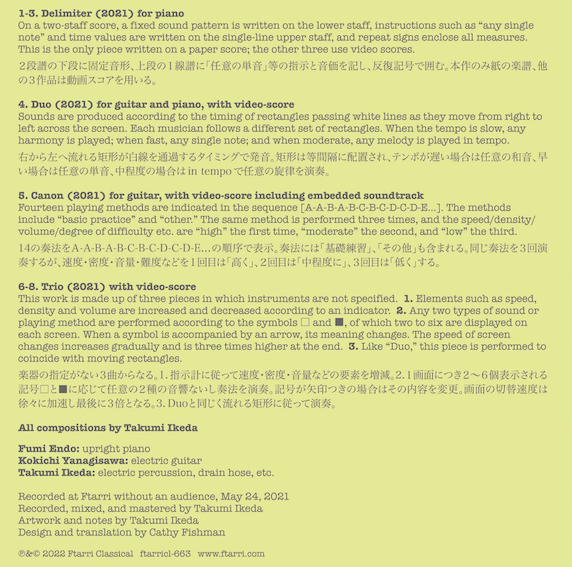

CD
ftarricl-663
Limited edition of 200
Out on February 27, 2022
Ftarri Bandcamp
Fumi Endo: uplight piano
Kokichi Yanagisawa: electric guitar
Takumi Ikeda: electric percussion, drain hose, etc.
All compositions by Takumi Ikeda
Recorded at Ftarri without an audience, May 24, 2021
Recorded, mixed, and mastered by Takumi Ikeda
Artwork and notes by Takumi Ikeda
Design and translation by Cathy Fishman
This CD documents a series of works that I call "Musical Procedure." In composers' usual works, the sounds to be performed are written in a score; but in these pieces the procedures (which could also be called programs, algorithms or specification sheets) for shaping music, such as performance methods and the general ideas of the works, are written as concisely as possible, and the type of sound to be produced is left largely to the performers.
The score is merely an arrangement of tools for creating music, and the musicians are always the subjects who produce the music. They are expected not just to execute what is written down, but to use what is written to create their own music. The result can be likened to an ants' nest or a beehive constructed in a procedural way without a blueprint.
In the works of Musical Procedure, an inevitable result of the composition method is that the influence of specific musical genres is to some extent removed, with the exception of aspects like instrumental playing methods. (Omitting the concept of notes is possible, too, as in the first piece in "Trio.") The idea behind the works is that awareness of patterns precedes sound image. For this reason, the pieces also suggest an approach to music that is independent of context, or neuro-atypical. Since the current world situation calls for constraints on group activity, it seems
to me that the possibilities of music like this, which keeps a distance from groups, will further increase the significance of considering this approach.
1-3. Delimiter (2021) for piano
On a two-staff score, a fixed sound pattern is written on the lower staff, instructions such as "any single note" and time values are written on the single-line upper staff, and repeat sighs enclose all measures. This is the only piece written on a paper score; the other three use video scores.
4. Duo (2021) for guitar and piano, with video-score
Sounds are produced according to the timing of rectangles passing white lines as they move from right to left across the screen. Each musician follows a different set of rectangles. When the tempo is slow, any harmony is played; when fast, any single note; and when moderate, any melody is played in tempo.
5. Canon (2021) for guitar, with video-score with embedded soundtrack
Fourteen playing methods are indicated in the sequence [A-A-B-A-B-C-B-C-D-C-D-E...]. The methods include "basic practice" and "other." The same method is performed three times, and the speed/density/volume/degree of difficulty etc. are "high" the first time, "moderate" the second, and "low" the third.
6-8. Trio (2021) with video-score
This work is made up of three pieces in which instruments are not specified. 1. Elements such as speed, density and volume are increased and decreased according to an indicator. 2. Any two types of sound or playing method are performed according to the symbols □ and ■, of which two to six are displayed on each screen. When a symbol is accompanied by an arrow, its meaning changes. The speed of screen changes increases gradually and is three times higher at the end. 3. Like "Duo," this piece is performed to coincide with moving rectangles.
(By Takumi Ikeda)
Takumi Ikeda is a Tokyo-based composer and computer music artist who uses musical and general programming language in composing and performing. His works have been commissioned and premiered by artists and groups such as Tokyo Gen'On Project, Tambuco Percussion Ensemble, Ensemble for Experimental Music and Theater, and Vox humana. Since 2011, Ikeda has been performing in the trio Electric Powered Music along with Masamichi Kinoshita and Tomoki Tai. Their CD Electric Powered Music Concert was released on the Meenna label in 2018.
This album documents performances of four pieces that composer Takumi Ikeda calls "Musical Procedure." In composed pieces the sounds to be performed are usually written in a score; but in the "Musical Procedure" pieces, procedures for shaping music (such as performance methods and the rough outlines of the works) are written extremely simply, and the type of sound to be produced is left largely to the performers.
The four pieces on this CD are "Delimiter" (for solo piano), "Duo" (for guitar and piano), "Canon" (for guitar), and "Trio" (performed by three musicians). The three works other than "Delimiter" utilize video-scores. The musicians are Fumi Endo (piano), Kokichi Yanagisawa (electric guitar) and Takumi Ikeda (electric percussion, drain hose, etc.). The CD actually contains eight tracks, since "Delimiter" and "Trio" are divided into three tracks each. The performances were recorded without an audience at Ftarri, Tokyo, on May 24, 2021.
